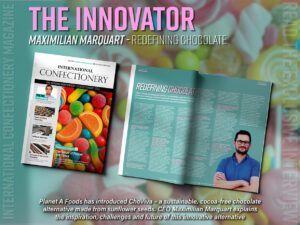Technical Editor, Clay Gordon, discusses new alternatives to sugars and sweeteners, its history, and growing popularity focusing on how the industry desires to replicate flavour.
To modern tastes, the histories of chocolate and sugar are as dance partners engaged in an intimate flavour tango: For what is chocolate without sugar?
For the vast majority of its history, sugar – or a sweetener of any kind – was not a part of the ingredient or flavor lexicons of chocolate. According to food historians, the Aztecs used many substances to flavour their chocolate beverages: Chili peppers, maize, earflower (Cymbopetalum Penduliflorum), vanilla, rosita de cacao, and more were popular additions; but not a sweetener is to be found in the pre-Hispanic historical record. Endemic to Mesoamerica, melipona bees did produce small quantities of honey but there no record has been found of it being used with cacao. Sugar cane originated in India and was introduced to the Americas by conquering Europeans; the European honeybee (Apis mellifera L.) was not introduced into the Americas until the early 1620s.
In fact, the first Europeans to encounter the “proto chocolate” consumed by the indigenous peoples of Mesoamerica were not impressed by what they tasted. While they quickly came to appreciate its importance and value to the natives, they did not initially appreciate its bitter taste, nor the fact that it probably would have been served at close to ambient temperature, not hot.
But then someone got the idea to add sugar and heat the concoctions up. These innovations would transform European attitudes toward cacao and lead to it joining sugar and other spices as an important economic driver of colonial expansion. This symbiosis between sugar and chocolate continued unquestioned for hundreds of years. In fact, it’s possible to argue that sugar and milk, because they were vastly cheaper than cacao, were crucial to the widespread growth of chocolate consumption – in the form of milk chocolate candy beginning in the 1870s pioneered by Henri Nestlé and Daniel Peter. Nestlé, Peter, Cadbury, Hershey – their genius was not that they necessarily made great (or even good) chocolate, it was that they made chocolate affordable.
Over the past half century, the role of sugar plays in our diets has come under increasing scrutiny. Where in the 1960s, in the US, nutritional policy (probably wrongly in hindsight) demonised all forms of dietary fats, it has become increasingly clear that dietary sugar levels can have more significant – and perhaps even broader – health impacts. In response, there has been a movement to find alternatives to sucrose (aka saccharose), fructose, and glucose that satisfy the desire for sweetness without the associated negative impacts on health and wellness.
This functional approach to sugar alternatives has dominated, until only very recently, how food scientists and industry have viewed their development and use.
Two early alt. sugars were sodium cyclamate, discovered in the 1930s and about 50 times sweeter than sucrose, and saccharin, discovered in the 1870s and 300-400 times sweeter than sucrose. Neither of these substances contain any calories (usable energy) and so they were used as sugar replacements for people with a desire or medical need, e.g., diabetes, to regulate sugar intake. Apart from some pretty serious potential side-effects related to consumption, these two sugar alternatives share a trait common with many other sugar replacements – odd tastes, especially a metallic bitterness. For some, this usually negative trait became closely associated with an almost cult-like devotion to some products; consider the diet soft drink TAB.
Many alternative sweeteners are hundreds of times sweeter than sucrose with some negative flavour aspect such as erythritol’s cooling sensation due to what is called negative heat of solution. Allulose, while containing only 10% of the calories of sugar (0.4 per gram as opposed to sucrose’s 4 per gram) is only roughly 70% as sweet as sugar, so to achieve the same level of perceived sweetness, recipes must adjust.
Sweetness level and taste relative to sucrose are just two of many product and process-dependent factors – for example, in bakery applications sugar is considered a liquid ingredient – that need to be explored when formulating or considering a sugar replacement in any product. In industrial-scale applications chemical and heat stability also need to be considered. Sucralose is suspected of beginning to break down at temperatures above 119C. And let’s not overlook the fact that some sugar alcohols, maltitol for example, are infamous for causing unpleasant gastrointestinal side effects when consumed in too-large quantities.
Of major interest in many confectionery and baking applications is how, or even if, the replacement caramelises. Many replacement sweeteners, including stevia and monk fruit extract, do not on their own caramelise.
One fairly new entry into the sugar replacement market, Zùsto, is comprised of proprietary blends of dietary and prebiotic fibers in combination with extensive (less sweet than sugar such as allulose) and intensive (sweeter than sugar, such as monk fruit) sweeteners that can be tailored to specific application and customer requirements. Advertised as a 1:1 replacement for sugar in many applications, one thing that Zùsto does, that many other alt.sugars do not is caramelise, making it an option for chocolate makers, confectioners, and bakers looking for a sugar replacement that works more like “real” sugar.
“We all agree that taste is the number one goal,” said Maxim Greant, Sales and Export Manager for Belgium-based Zùsto. “First, everyone agrees that it has to taste like sugar, and then it’s best if it works like sugar. Our goal was to develop a replacement for sucrose, something that would not just taste like sugar, but that would make delicious and healthy products as tasty and as healthy as possible. We also knew we needed to make it convenient to use in the widest variety of environments and applications – for industrial and artisanal ice cream and gelato makers; in industrial and artisanal bakery, pastry, and confectionery manufacturing, for bean-to-bar chocolate makers, and for home chefs.”
“Compared with cane or beet sugar,” continued Greant, “Zùsto is more expensive. But compared with other sugar replacements it’s very price competitive. Consumers have come to expect that a fiber based, healthier-for-you, sugar-free product will be more expensive than a conventional product and are very responsive when they find out there is no sacrifice in taste or texture.”
Notwithstanding, the focus on functional performance, including how sugar-like the replacement is, downplays another fundamental aspect of sugar alternatives as ingredients – how they can be used creatively to achieve new, different, and unique flavours and textures in confectionery and bakery products, and in chocolate.
The idea that sugar has a taste is not new.
There can be a discernible difference in the flavours of refined white sugars derived from beets and sugar cane. Unrefined cane sugar has a light-tan appearance from residual minerals and other substances that are not removed from the juice before crystallisation. These residual substances add flavour to the sugar, not just color. In turn, the sugar flavours whatever is made with it. Unrefined sugars from different producing countries can have different flavour profiles.
Piloncillo is highly unrefined sugar with intense molasses notes and a high moisture content. Belgian candi sugar is typically made from refined beet sugar that has been caramelised and is often used in brewing beer, particular Lambic-style beers fermented using strains of Brettanomyces yeast. Both types of conventional sugar, because of their flavour and technical characteristics, provide makers with interesting, and largely overlooked, creative opportunities.
Coconut palm sugar has become very popular over the past decade among specialty (craft, artisanal) chocolate makers. Many, but not all, varieties of coconut palm sugar are very high moisture, making them, like piloncillo, technically challenging to use in chocolate, where water can negatively affect the rheology of the chocolate as well as its ability to temper easily or at all. Liquid sweeteners such as agave syrup and honey are both, for this reason, not widely used in chocolate manufacturing. In some instances, the difficulty to temper and high-water activity (aW) level are turned into a product feature in chocolate confections that are fudge-like in consistency and that must be kept refrigerated until consumed.
Sugars derived from coconut nectar or that have been less highly refined and that have distinctive tastes are less acceptable options for many small chocolate makers who make two-ingredient, single-origin chocolates because the flavour of the sugar can obscure the unique flavours of the cocoa, which are influenced by genetics, terroir, post-harvest processing, and roasting – which is what these makers seek to highlight – absent any influence that can be attributed to the sweetener.
One alternative to refined sugar that is not an alt.sugar (in the modern conventional sugar replacement sense) has a tradition dating back to the 17th century in Holland and that has recognized with a geographic indicator: Basterdsuiker (pronounced sow’-cur, sœykər) or hybrid sugar. Basterd (bastard) refers to the impurities that are left behind in the manufacturing process. To be called basterdsuiker, a sugar must be produced in the Netherlands using beet sugar, other specific ingredients via specified processes.
As a result of the way it is made, basterdsuiker contains inverted sugars. The sucrose content must be at least 90% of the dry matter content, the invert sugar level can be as high as 10% though typically it is between 0.5% and 3%. This chemical composition has a wide range of effects on products made with it. These include the browning of baked goods at lower temperatures as well as affecting the perception of moistness. This effect can be so pronounced that it led to the development of what the Dutch refer to as wet cake Zeeuwse Bolus (sticky type of cinnamon bun) and Vlaardingse IJzer Koekje (cookie with crispy outside and a raw cookie dough-like center)
Basterdsuiker is widely available in markets throughout the Netherlands and is a part of many common, popular recipes, making it a very different sweetener choice than glucose syrup or sorbitol which are usually only available from specialty ingredients suppliers (or Amazon). Three different varieties of basterdsuiker are made, with different percentages of inverted sugar and other components. These three varieties correspond to what Americans call white, light brown, and dark brown sugar and are made in similar ways. In the US molasses is added to white sugar in different amounts. Pale/yellow basterdsuiker, which contains between 1.5% and 2.5% invert sugar, is made by adding a specific amount of a syrup containing invert sugar and caramel to white sugar. In the dark/brown variety the syrup contains between 1% and 2% invert sugar and more caramel. In addition to having some unusual technical properties compared with conventional sugar, white basterdsuiker has distinctive overtones of honey and nuts that is more pronounced in the darker varieties.
From experience working in new product development in specialty chocolates aimed at health-conscious consumers I can personally attest to how difficult it can be to create a proprietary, and tasty, alt.sugar blend. One client’s goal was to achieve a level of sweetness on par with conventional sugar with a much lower glycemic index. To achieve something palatable at the desired cocoa content level, and to balance the flavours of other ingredients in the chocolates, the blend included coconut sugar, monk fruit extract, stevia, erythritol, and lucuma, plus others.
I have never had a client ask me for help with a recipe where the primary consideration with respect to the sweetener was, “What new and interesting can the sweetener bring to the table, flavour wise, that will enable us to bring something differently tasty to market.” And in that direction lay, in my opinion, a very tasty future for chocolate.
Ewald Rietberg & Jan-Willem Jekel, Heinde & Verre Chocolate Makers, Rotterdam, The Netherlands:
The name, “Heinde & Verre,” translates to ‘near and far’ and pays homage to the Dutch culinary tradition of combining ingredients sourced from the four corners of the Earth with locally grown and made ingredients.
While the Netherlands may be a world-leading processor of cocoa, cocoa does not actually grow in the Netherlands. We source it from far places like Bali, Brazil, and Perú. We combine that with nearby ingredients – locally produced dairy, beet sugar, and endemic hazelnut varieties for example.
Because of our cultural and culinary backgrounds, we are very familiar with basterdsuiker in pastry and baking – it is a key ingredient in many popular Dutch baked goods. But it’s not used very much in chocolate. So, when we were exploring making a Dutch version of the Italian favorite gianduia, we were intrigued to learn how the flavour of basterdsuiker might complement the flavour of our endemic hazelnuts. We did not know precisely how the chemical properties might influence the mouthfeel – the bite, chew, and melt of the gianduia – it was first and foremost a flavour-driven process.

The first decision we had to make was whether to use the white, light, or dark version of basterdsuiker. The major difference between the three is the amount of syrup that is added to them, with the white having none and the dark variety having the most. This decision had an impact on color and flavor. In the end, we decided to go with the light version because it did not overwhelm the cocoa or the nut flavors, instead enhancing them with its honeyed notes.
We also found it interesting that the basterdsuiker made it possible to incorporate a greater quantity of hazelnuts into the chocolate and that tempering was less finicky, an exciting and unexpected bonus.
Vincent Bulteel, Executive Pastry Chef, Master Chocolatier, Health/Nutrition Counselor, and Zùsto Ambassador:
Literally no one is saying that because sugar does not meet every need in every application that it is no good,
When replacing sugar in a recipe we’re looking to achieve a balance of organoleptic and functional characteristics. Zùsto has a sugar-like fully rounded mouthfeel that single ingredients (such as erythritol) on their own are missing. If you make a simple syrup with erythritol it will crystallise when it cools down. With Zùsto that does not happen, the syrup behaves as you’d expect a syrup made with sugar to behave. Zùsto is formulated with a high percentage of prebiotic fiber, an important contributor to its healthful nutrition profile. The fiber also stabilises moisture which makes it an excellent choice in formulating ganaches where water activity is a challenge when replacing sugar.

Finding a replacement for sucrose is important because that is what every baker, confectioner, ice cream and gelato maker – and every home chef – already has on their shelf and is what is called for in their cookbooks. There are many recipes, such as pâtes de fruits, where glucose is used because glucose has properties that sucrose does not have. Zùsto is not magical so it does not change those aspects of the chemistry of a recipe, but because Zùsto so closely mimics real sugar in other ways, it is usually the case that few or no other changes need to be made to a recipe when replacing sucrose in a recipe with Zùsto.
To stay up to date on the latest, trends, innovations, people news and company updates within the global confectionery market please register to receive our newsletter here
Media contact
Roshini Bains,
Editor, International Confectionery
Tel: +44 (0) 1622 823 922
Email: [email protected]









